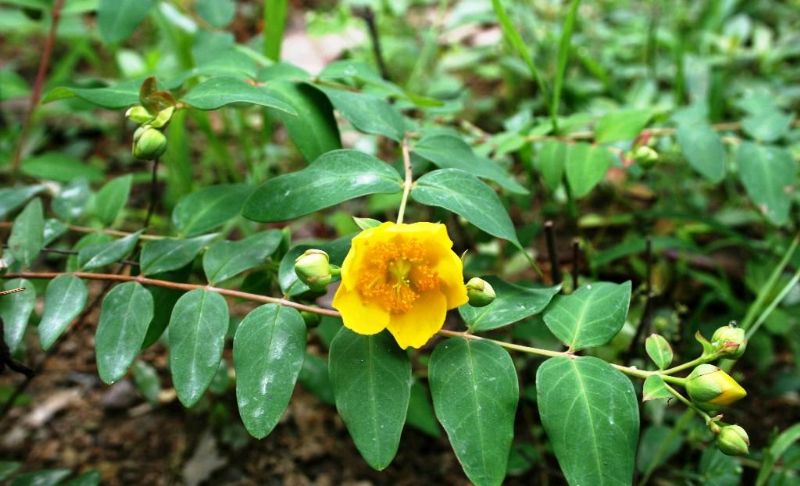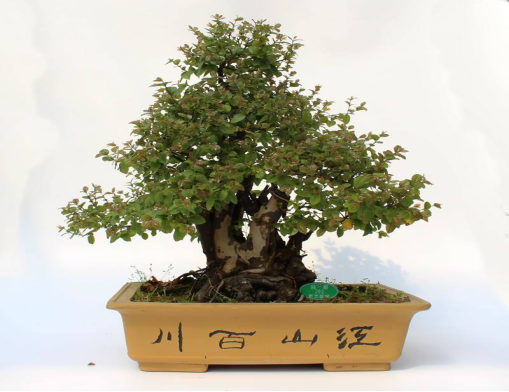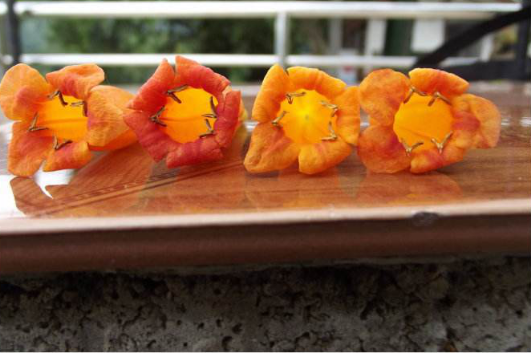Propagation method of Prunus mume
1. Cutting propagation
In spring or autumn, select a few healthy branches, cut them into 10-15 cm long cuttings, and soak them in auxin or rooting powder. Gold plum seedbed to irrigate water, water can be cutting backward, often irrigation, loose soil.
2. Plant division and propagation
Rite propagation usually takes place in spring or autumn. The ramets must bring soil balls to improve the survival rate. The roots of golden plum can be wrapped in nylon bags or planted directly in flower pots. Do not damage the roots of golden plum as much as possible. After digging and packaging, transport them in time and water them frequently.

Now I believe that you have a certain understanding of the cultivation of Jinmei, if you also like Jinmei, then take action, in this beautiful season planted a Jinmei belongs to their own.
What is the meaning of the word "gold"?
Gold plum flowers large, colorful, flowering up to 10 months, is the best choice for home potted plants. What is the meaning of the word? How do we reproduce? So let's get to the bottom of it.
1. What is the golden plum flower language?
The words of the golden plum: hate sadness
Gold plum for gamboge family semi-evergreen or evergreen small shrubs, red or dark brown twigs. Leaves opposite, ovate, long ovate, or ovate-lanceolate. Flowering from April to July, fruiting from July to October. Flowers solitary branch end or into cymes, flowers 4 cm in diameter-5 cm, golden yellow, stamens numerous, even synthetic 5 bundles, golden yellow.
Jinmei is born on slopes or valleys under sparse forests, roadsides or shrubs, 450-2400 meters above sea level. For temperate, subtropical tree species, slightly cold-resistant. Likes light, slightly tolerant of shade. Developed root system, strong germination, pruning resistance. Strong nature, avoid water. It grows on well-drained, moist, fertile sandy loam.
II. Breeding methods of golden plum
Gold plum can be used to plant propagation, cuttage propagation, seeding propagation, when a large number of seedlings, can be used for tissue culture propagation.
1, ramet propagation: ramet propagation is generally carried out in spring or autumn cultivation. The ramets must have soil balls, which is beneficial to survival. The roots of golden plum can be wrapped in nylon bags or planted directly in flower pots. Try not to destroy the roots of golden plum. While digging, pack them. After digging and packing, transport them in time. Watering frequently is beneficial to survival.
2, cuttage propagation: cuttage is generally carried out in spring or autumn, select 1-2 strong growth branches, cut into 10-15 cm long cuttings, cut flat under the slope, and auxin or rooting powder soaking treatment. The seedling bed of golden plum should be watered thoroughly, and cutting can be done after water falls behind. The plant spacing is 10 cm ×10 cm, and the cutting depth is 2/3 of the cutting length. The management is mainly irrigation, loosening and weeding.
3. Seed propagation: soaking seeds in warm water for 1-2 days before sowing can obviously improve the germination rate of Jinsimei seeds. Deep ploughing and fine harrowing are required, and sufficient base fertilizer is applied to make flat beds 1.0-1.5 meters wide, waiting for sowing. Spring, autumn sowing, generally in the spring late March or early April sowing, windless weather, the best 2-3 days after sowing without heavy rain or rainstorm, the use of drilling or sowing can be covered with topsoil about 1 cm, bed cover grass and watering wet, 10 days after sowing seedlings, 20 days or so out of Qi.
The above is the introduction of Jinmei flower language and Jinmei breeding method, I hope to help everyone, but also want to know more Jinmei knowledge continue to pay attention to us.
How to breed and cultivate Jinmei
Jinsi Mei is a semi-evergreen or evergreen shrub of Garcinia family. It has the effect of clearing heat, removing dampness and detoxifying; soothing liver and dredging collaterals; removing blood stasis and relieving pain. The golden plum grows in many places in our country. Let's see how the golden plum breeds. Propagation and cultivation method of golden plum.
Introduction of Jinmei
Hypericum patulum Thunb. ex Murray) is a semi-evergreen or evergreen shrub of Garcinia family, with red or dark brown twigs. Leaves opposite, ovate, long ovate, or ovate-lanceolate. Flowering from April to July, fruiting from July to October. Flowers solitary branch end or into cymes, flowers 4 cm in diameter-5 cm, golden yellow, stamens numerous, even synthetic 5 bundles, golden yellow.
Jinsi Mei is distributed in southern Gansu, Shaanxi, Hubei, Hunan, Sichuan, Anhui, Jiangsu, Zhejiang, Fujian, Guizhou, Yunnan, Taiwan and other provinces in China. Gansu Province is the northern boundary of this species 'natural distribution. It is produced in Wudu, Kang County and Wen County in Gansu Province.
How does the golden plum reproduce?
After breeding test, the propagation of Jinsi Mei can be carried out by plant division, cuttage propagation, sowing propagation, and tissue culture propagation when a large number of seedlings are needed.
1. Sowing method
The method is carried out in the fruit maturity period from August to September of each year, and the golden plum with good growth is selected for picking, seeds are kneaded after the capsules are dried, and pure seeds are obtained after air drying for later use. Generally stored in bags at low temperature, soaking seeds in warm water for 1-2 days before sowing can obviously improve the germination rate of Jinsimei seeds. Deep ploughing and fine harrowing are required, and sufficient base fertilizer is applied to make flat beds 1.0-1.5 meters wide, waiting for sowing. Spring, autumn sowing, generally in the spring late March or early April sowing, windless weather, the best 2-3 days after sowing without heavy rain or rainstorm, the use of drilling or sowing can be covered with topsoil about 1 cm, bed cover grass and watering wet, 10 days after sowing seedlings, 20 days or so out of Qi.
II. Cutting propagation
Generally carried out in spring or autumn, select 1~2 healthy branches, cut into 10-15 cm long cuttings, cut flat and inclined, and soak them with auxin or rooting powder. The seedling bed of golden plum should be watered thoroughly, and cutting can be carried out after water falls behind. The plant spacing is 10 cm ×10 cm, and the cutting depth is 2/3 of the cutting length. The management is mainly irrigation, loosening and weeding.
With river sand or pearlite as cutting medium, the survival rate of cuttings is higher; with the upper part of branches as cuttings, the growth of roots of cuttings is better; with indolebutyric acid treatment, the survival rate of cuttings and the growth and development of cuttings can be promoted to a certain extent. When cutting propagation was carried out, river sand or pearlite was used as cutting substrate, and the middle and upper parts of new shoots were used as cuttings. After treatment with indolebutyric acid, higher survival rate and higher quality of cuttings were obtained.
III. Plant division propagation
Raiders are generally propagated in spring or autumn cultivation. The ramets must have soil balls, which is beneficial to survival. The roots of golden plum can be wrapped in nylon bags or planted directly in flower pots. Try not to destroy the roots of golden plum. While digging, pack them. After digging and packing, transport them in time. Watering frequently is beneficial to survival.
IV. Tissue cultivation
1. Acquisition of materials
selecting young twigs of golden plum in the current year, washing in running water, cutting into 3 cm long, absorbing excess water with filter paper, soaking in 70% alcohol for 20 seconds on an ultra-clean workbench, washing with sterile water for 3 times, then transferring into 0.1% mercuric chloride solution, shaking for 5 minutes, washing with sterile water for 5 times, then placing into a small disk covered with filter paper after autoclaving, cutting into small stem segments with a bud of 0.5-1.0 cm, inoculating in differentiation culture medium, and culturing.
2. Bud induction
After 20 days, the sterile small stem segments differentiated into buds at the stem nodes, and the buds were 1-2.5 cm long after 30 days. At this time, the obtained clustered shoots were cut off, cut into about 1 cm segments and transferred to the proliferation medium for culture. After 40 days, the average seedling height was 3-4 cm, and the proliferation coefficient was 6 - 8 times.
3. Rooting and transplanting
When the buds grow to 2-3 cm high, cut the tender stems and transfer them to the rooting medium. After 2 weeks, each plant takes 3 - 5 roots, and the rooting rate reaches 99%. After rooting, the test-tube seedlings are placed in a greenhouse for 5 days without opening the cover, placed in a greenhouse for 2 days after opening the cover, taken out and cleaned, soaked in clear water for 2-3 hours, transplanted into a substrate of vermiculite, river sand and forest soil (5:1:3), covered with a plastic film, covered with a shade net to prevent direct sunlight, kept at about 90% humidity, removed after 10 days, new roots and new leaves begin to develop, and the survival rate is 93.6%. After 20 days, the surviving seedlings are transferred to forest soil and pastoral soil (1:1) matrix, the plant spacing is 10cm X15cm, attention is paid to moisture and illumination, the survival rate is 98% after 15 days, when the transplanted seedlings grow to 15- 20cm, transplanted to the field with soil, irrigated with sufficient water, and the seedlings begin to grow vigorously after one week.
Cultivation Techniques of Jinsimei
1. Field excavation
From early February to mid-March every year, most of the leaves lag behind before the soil freezes from late October to mid-November.
2. Mining and transportation
Bare root digging, try not to hurt the root system, cut smooth when cutting roots, do not split, after digging out, it is best to cover plastic bags on the root system, or soak roots with humectant, root system mud and other methods, which is conducive to improving the survival rate. Long-distance transportation is best with soil balls, soil balls should be complete, packaging should be tight, and poured with sufficient water; tree crowns should be wound with straw rope to reduce friction damage and improve survival rate.
3. Digging
Cultivation pit must be dug in advance, if the seedlings arrive, should be immediately planted. The pit diameter should be 20~30cm larger than the root system or soil ball diameter, so as to facilitate the extension of old roots and the development of new roots. The topsoil and subsoil in the pit should be placed separately. The bottom of the pit is large and flat. When conditions permit, some organic fertilizer can be applied and covered with topsoil.
4. Cultivation
Before cultivation, the roots should be trimmed and cut flat to facilitate healing. When cultivating, the root system must be stretched, first put the topsoil, layered and solid, so that the root system and the soil are closely combined. Surrounding the earth weir, irrigation immediately after planting enough water, 3 days after pouring the second time permeable water, 1 week after pouring a permeable water, to ensure survival.
5. Watering and fertilizing
Watering: after the bud sprouts to flowering period, water 2-3 times as appropriate, and then water 2-3 times in summer drought. Pay attention to drainage and waterlogging prevention in rainy season. Avoid ponding. Pour antifreeze water once in winter.
Fertilization: apply enough decomposed organic fertilizer before cultivation, and then apply decomposed compost around the rhizosphere after defoliation in autumn every year. In general, topdressing is not necessary in growing season to avoid excessive growth and drooping of branches, which will affect the viewing effect.
6. Weeding
In order to make flowers flourish, it is necessary to strengthen intertillage and weeding. In dry season and midsummer, loosen soil and weed once every 2-3 weeks. After each irrigation, loosen soil in time to prevent soil hardening and improve soil permeability, so as to facilitate root growth and development. Weed every 2 weeks in rainy season.
7. Shaping and pruning
Every summer or winter for pruning, cut off excessive long branches, weak branches and pest branches, and according to the needs of the model cut short long branches. Through pruning, the plant maintains good tree shape and vigorous tree vigor, so that the plant grows healthy, flowers and leaves flourish, thus improving the ornamental value.
8. Disease control
There are few diseases and insect pests in Jinsimei, mainly aphids. The control methods include: cutting off the injured branches or dry leaves in winter and summer, eliminating part of the overwintering eggs and insect sources; spraying 5% engine oil emulsion or 5% diesel oil emulsion to kill overwintering eggs before germination in winter or early spring; At the early stage of occurrence in April and May, spraying 40% omethoate EC 1000-1500 times, 20% methamidophos EC 2000 times, 50% methamidophos EC 1500 times or 2.5% dichlorothrin EC 3000 times, 2-3 times can control; at the peak of damage in May and June, spraying 40% omethoate, monocrotophos and other hygroscopic insecticide oil 10-20 times on the trunk ring or soaking roots, the effect is good.
- Prev

The reason for the yellowing of Finch Plum leaves
First, if left outdoors, the basin soil may be too dry or too wet, especially due to stagnant water after rain and poor drainage. Second, put it indoors in a sultry, unventilated shade for a long time, or suddenly move to the outside to be exposed to the sun. The sparrow plum after falling leaves, as long as the branches do not wither, there are still residual leaves.
- Next

Propagation methods of Burning Flowers
Because of its multi-season flowering, burning flowers can be collected in many seasons, so sowing and reproduction is the main method of reproduction. When the pericarp changes from cyan to dark brown, the fruit is harvested and dried in a windless place. After the pericarp is cracked, the seeds are gently knocked out, and the seeds can be picked and sown in spring.
Related
- Fuxing push coffee new agricultural production and marketing class: lack of small-scale processing plants
- Jujube rice field leisure farm deep ploughing Yilan for five years to create a space for organic food and play
- Nongyu Farm-A trial of organic papaya for brave women with advanced technology
- Four points for attention in the prevention and control of diseases and insect pests of edible fungi
- How to add nutrient solution to Edible Fungi
- Is there any good way to control edible fungus mites?
- Open Inoculation Technology of Edible Fungi
- Is there any clever way to use fertilizer for edible fungus in winter?
- What agents are used to kill the pathogens of edible fungi in the mushroom shed?
- Rapid drying of Edible Fungi

